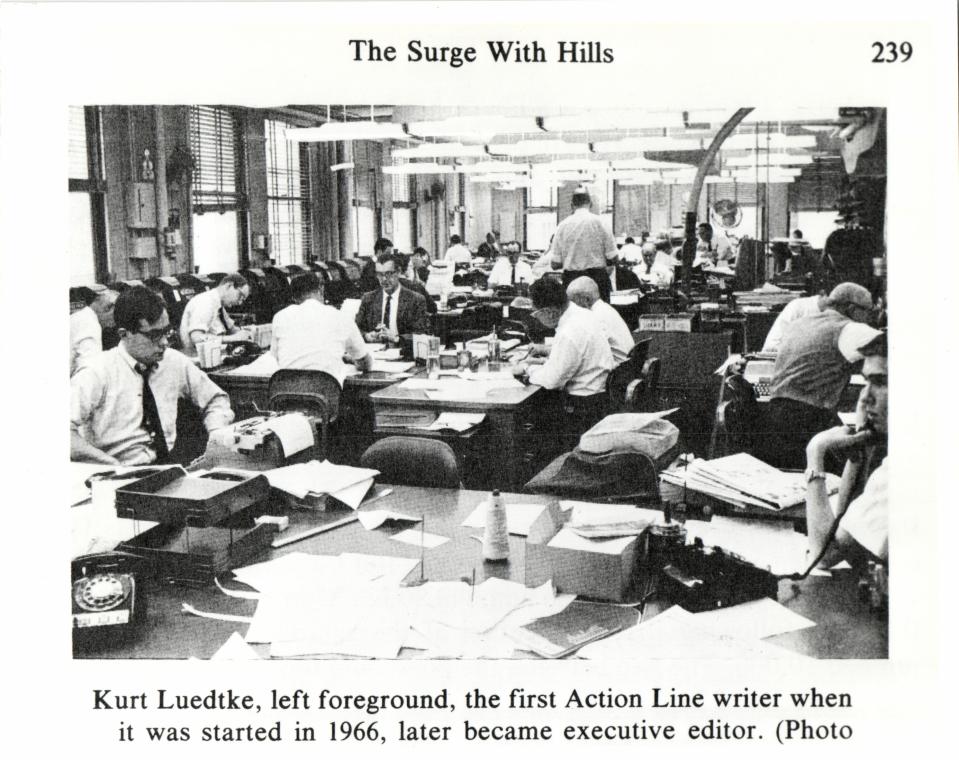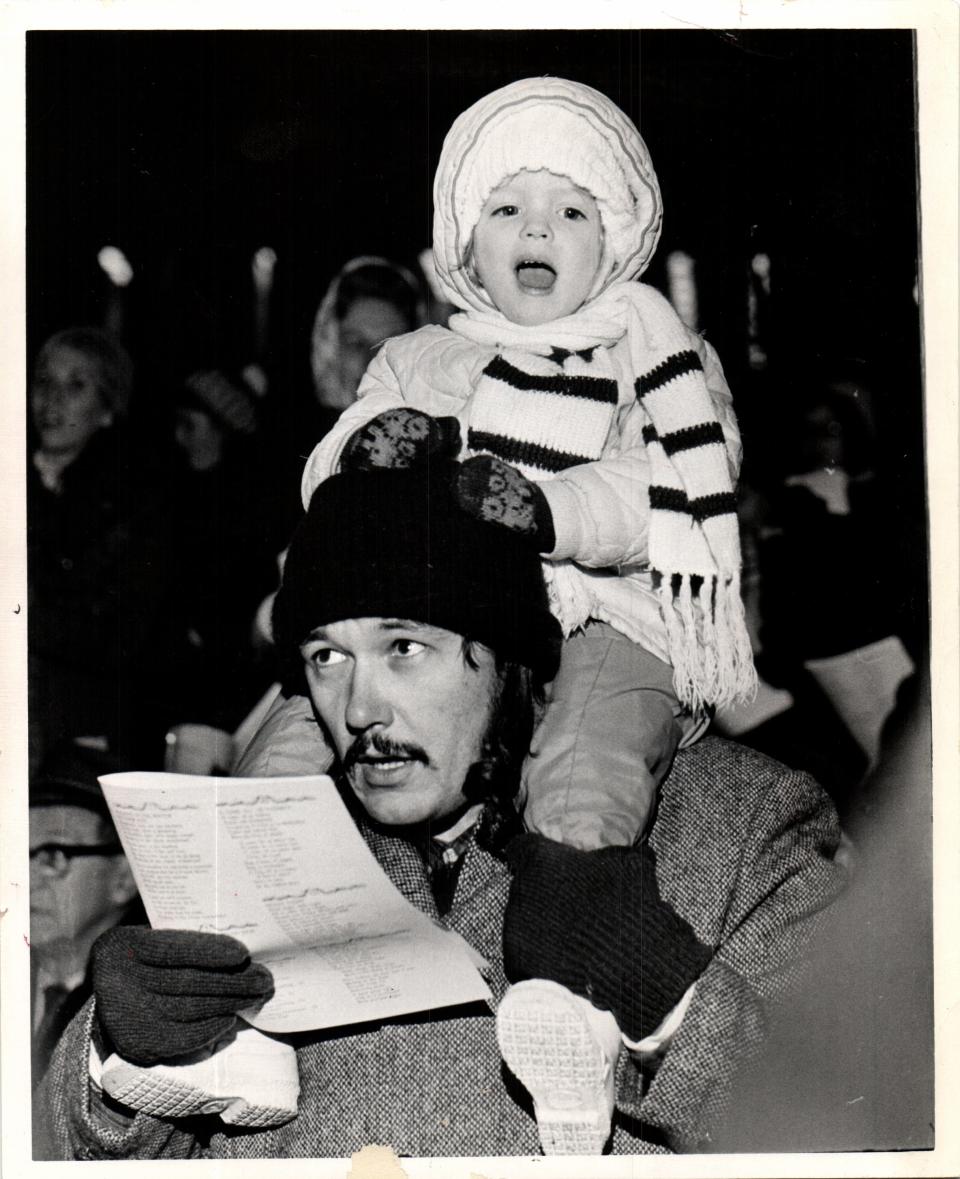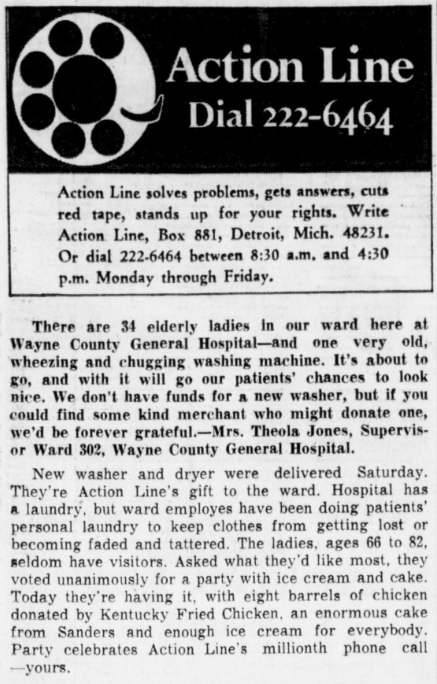A look back at Action Line, the Detroit Free Press' famous tipline
Editor's note: As viewers see the Free Press' masthead this week in a fictional Hallmark Mystery movie — "Tipline Mysteries: Dial 1 for Murder," which debuts Friday — here's a look back at the Free Press' real-life tipline, Action Line, a popular column that set the tone for consumer journalism in the 1960s and 1970s.

Action Line — it was Michigan's own superhero squad.
The provocative column of answers and solutions to readers' questions, needs and conundrums ran on the front page of every Free Press for more than 15 years starting in 1966. It had its own area in the newsroom and a staff of eight: Two full-time clerks dedicated to opening mail, transcribing letters and typing up readers' phone calls; five researchers, solving readers' problems and standing up for the little guy; and one wisecracking writer, who oversaw it all.
Its logo was a rotary dial and a description that said Action Line "solves problems, gets answers, cuts red tape, stands up for your rights."
An instant success
Action Line first asked readers to call in on Jan. 12, 1966, and received so many calls, it interfered with telephone service in downtown Detroit. Michigan Bell was forced to shut Action Line down for a few hours to get things back on track.
Two days later, Action Line officially became a column.
The concept of Action Line wasn't new.
In "On Guard: A History of the Detroit Free Press," Managing Editor Frank Angelo credits editor Derick Daniels, whom Angelo said took inspiration from a similar column in a Houston paper." Daniels credited Free Press Editor Tom Wark, calling him "father of Action Line," in Wark's obituary that ran in the Free Press in 2017.

Action Line's success was unparalleled and adoration for the column immediate. On April 7, 1966, just four months after Action Line began, the Free Press published a piece called "Free Press Readers Love Action Line" that featured "love notes" to the column. For many, Action Line was the first thing they read each morning, and one reader from Pontiac wrote that he subscribed to the paper for the sole purpose of reading Action Line.
Within a week of Action Line's introduction, Free Press circulation increased by over 10,000.
Tim Kiska, former Free Press reporter and editor, began working as one of Action Line's researchers in 1974. He stayed for two years until he was promoted in 1976 to write Tipoff, a behind-the-scenes column about Michigan newsmakers. He attributes Action Line’s success, in large part, to its first writer, Kurt Luedtke, who went on to write the screenplays for the film “Absence of Malice” and win an Academy Award for “Out of Africa.”

"It was a big hit, a huge hit, written in a really colorful and chatty sort of style and it was just fun to read," said Kiska, who was in high school when the column began.
In 1968, after Action Line helped cut the circulation gap between the Free Press and The Detroit News in half, the News introduced Contact 10, a similar column that referenced the 10 people they had working on it. But — as Kiska put it — "it just wasn't as fun to read."
"I'm not denigrating the News at all," said Kiska. "But the Free Press was always standing out because of Luedtke's style."
There were no bylines on the column, but the writer/editor was in charge of making sure there was a variety of problems printed every day and that each was easy and entertaining to read. In response to one mother wondering whether her son really needed a leather jacket for safety on his motorcycle, Action Line advised:
"Action Line checked with the motorcycle men of the traffic detail, who swear by 'em. They're not required by law, but the pros say nothing else offers as much protection if you take a spill on a bike. True, black leather jackets have become a symbol for hoodlum cycle jockeys, but remember: Good guys wear 'em, too, including policemen."
Successive writers continued Action Line’s conversational tone, which proved crucial to the column’s reputation and how it connected with readers.

Google before the internet
In some ways, Action Line served as a pre-internet Google. Curious where crystal balls are sold near you? Want to know how to safely watch the solar eclipse? Wondering why fire hydrants are different colors? Call Action Line. They would find out and let you know.
But Action Line's real power was in the good it was able to accomplish.
"Action Line said, 'Hey, we're on your side, we're going to bat with you,' " said Kiska. "It meant that you had a friend in a high place."
By Sept. 7, 1969, Action Line had received a million calls. Angelo celebrated with a short essay of thanks and celebrated some of the column's most impressive achievements.
"Action Line saved $2,700 for 200 of you by correcting an error on City of Detroit income tax forms; solved a child abuse case that led to reform in state laws; bought a house for one of Detroit's neediest families … and raised $4,000 for a slain policeman's widow and children," wrote Angelo.
Angelo quoted a reader named Judy from Taylor: “I don’t want anything. I don’t even have any problems to solve. I just think you’re the most wonderful people I’ve ever ‘known,’ and by reading Action Line every day, I feel as if I DO know you.”
Bill Laytner was hired as a researcher for Action Line in 1977 and was eventually promoted to editor of the column. He remembers having an entire portfolio of Blue Cross complaints that the team would pick up at the end of each week.
"We covered a wide swath of problems in the world that weren't getting the kind of attention they should have been getting," said Laytner, who still writes for the Free Press. "Action Line tried to step in when there was clear abuse."
Action Line followed a predictable format, but wasn't repetitive. The most serious or high impact item led the column, followed by five or six other briefs, with at least one that was lighthearted (a barber who became allergic to human hair, a reader wondering whether a lion and a tiger could get along, a woman wondering why dogs don't watch TV) and usually accompanied by a small illustration.

As much as Action Line stood up for its readers, it wasn't afraid to call them out either. One caller complained that they never received winnings from a Buick sweepstakes. Action Line checked it out and responded curtly, "You didn't win. … Dealer you registered with had no winners but did have a separate contest for a TV set: you didn't win that either."
In addition to being funny and effective, Action Line seemed invincible. Not even time could hold it back. In a column that ran on April 9, 1966, a reader was scheduled to be married at 3:30 p.m. On the day, however, the marriage license bureau informed the couple that it could not accept the fiance's health certificate because it was done at a laboratory the bureau didn't recognize. Desperate to hold the ceremony at the church they had chosen and already decorated, the couple turned to the one place they knew would save the day.
In a matter of hours, Action Line responded.
"Your marriage license cleared the bureau at 2:55 p.m., leaving you 35 minutes to get to the church. We don't know how you feel but we're exhausted. Action Line arranged for another blood test, quick results, Probate Court waived the three-day waiting period, marriage license bureau expedited the license. Whew!"
"We had clout," said Kiska, now a professor of communications at the University of Michigan-Dearborn. "People knew that everyone read Action Line and if we (expletive) this up, it's going to be on the front page of the paper. Many hundreds of thousands were reading it."
Action Line fixed potholes, returned birth certificates and won a lot of refunds. However, it wasn't without controversy. Laytner said it was widely known in the newsroom that Action Line's focus on consumer greivances prompted advertisers to pull hundreds of thousands of advertising dollars a year.
"We tried not to do it in an egregiously negative way. We tried to just tell it how it was," Laytner said. "But no advertiser wants anything negative."
For more than a decade, the increase in newspaper sales and subscriptions that Action Line brought in outweighed the lost advertising revenue. But in the early 1980s, Action Line finally met its match.
A slow demise
In the early 1980s, concerns over the costs of Action Line grew. The column continued to lose the paper advertising dollars and took up prime real estate on the front page that could have been used to better showcase the big stories, Laytner said. In 1980, half of Action Line was moved to 11A, and in 1981 it was moved off the front page entirely.
The column also began to lose its novelty, Kiska said.
"People are always looking for something a little bit different," he said. "At first, consumer journalism was getting a ride … but after a while, people say 'I've seen this before.' "
On the front page, Action Line was replaced by a column called Q that ran Q&As with different political leaders and local celebrities. Q didn't call out potential advertisers and didn't run every day, so it could be cut if there was a big story that day.
By the end of 1982, Action Line had only a couple questions printed on 2B of the paper with a note at the bottom asking readers to "keep those cards and letters coming."
Changes in consumer protection policies hindered Action Line, too. In its early days, Laytner said, Action Line would call the consumer protection service at the companies and businesses that had aggrieved readers. Since then, however, many laws that Action Line used to get things sorted, like the Michigan Consumer Protection Act, no longer apply.
"The teeth were taken out of (the MCPA)," Laytner said. "If you had a complaint about a stockbroker in 1978, that would be an interesting story, and Action Line could fix it. But now, you can't do anything because of the mandatory arbitration. There's not nearly as many places you can go as a consumer, or avenues you can pursue."
In 1983, these shifts defeated Action Line once and for all.
Still, today, readers and former Action Line staffers fondly remember the column and its mission.
"Bottom line," Laytner said, "we stood up for people, we got a lot of refunds and got a lot of institutions to keep their promises to people."
This article originally appeared on Detroit Free Press: A look back at Action Line, the Detroit Free Press tipline

